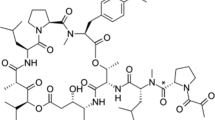Summary
Radiochemically pure 14C-labeled carboplatin, cis-diammine [1,1-cyclobutane (1-14C) dicarboxylato (2-)-0,0'] platinum (II), was added to fresh human, dog and rat plasma, at concentrations ranging from 1 to 100 μg 14C-carboplatin/ml. After 10 min incubation at ambient temperature, the plasma was ultrafiltered in Amicon Centrifree micropartition units to generate protein-free plasma ultrafiltrate (PU). Total radioactivity was determined by liquid scintillation counting. A mean (±SD) of 102%±2.0%, 99.5%±1.9%, and 99.0%±1.0% of the 14C-carboplatin added to fresh human, dog and rat plasma respectibely was recovered in the PU. 14C-carboplatin was incubated at 37°C with fresh plasma (60μg/ml) and urine (200 μg/ml) from humans and dogs for 120 h, and samples were removed at appropriate times for analysis of carboplatin, 1,1-cyclobutane dicarboxylic acid and cyclobutane carboxylic acid. The latter were separated by HPLC on a C-18 column with a mobile phase of H2O/CH3CN/0.3 M tetrabutylammonium phosphate (880:50:20 v/v/v), and the column eluants at the retention time of each compound were collected and counted for total radioactivity. Carboplatin degraded in each of the matrices with a corresponding release of 1,1-cyclobutane dicarboxylic acid. 14C-carboplatin (50 μg/ml) was incubated at 37°C with fresh human, dog and rat blood and the distribution of radioactivity into the cellular fraction was determined. Radioactivity did not distribute into the blood cells of humans or dogs, but after 5 h, 44% of the radioactivity in rat blood was associated with the cellular fraction. These results show that carboplatin, at physiological concentrations, does not bind instantaneously and reversibly to the plasma proteins of rat, dog or human, and that the molecule slowly degrades in plasma and urine in vitro with the release of 1,1-cyclobutane dicarboxylic acid. The remaining diammine platinum (II) portion of the molecule therefore accounts for the essentially irreversible protein binding of the platinum from carboplatin.
Similar content being viewed by others
References
Gaver RC, Deeb G (1986) High-performance liquid chromatographic procedures for the analysis of carboplatin in human plasma and urine. Cancer Chemother Pharmacol 16: 201–206
Harland SJ, Newell DR, Siddik ZH, Chadwick R, Calvert AH, Harrap KR (1984) Pharmacokinetics of cis-diammine-1,1-cyclobutane dicarboylate platinum (II) in patients with normal and impaired renal function. Cancer Res 44: 1693–1697
Harrap KR (1985) Preclinical studies identifying carboplatin as a viable cisplatin alternative. Cancer Treat Rev 12 (Suppl A): 21–33
Haynes VJ, Swigor JE, Pittman KA (1987) Synthesis of cis-diammine [1,1-cyclobutane-[1-14C]-dicarboxylato (2-)-0,0] platinum (II). J. Label Comp Radiopharmaceut 24: 535–539
Laznickova A, Laznicek M, Kvetina J, Drobnik J (1986) Pharmacokinetics and plasma protein binding of two platinum cytostatics CHIP and CBDCA in rats. Cancer Chemother Pharmacol 17: 133–136
Litterst CL (1984) Plasma pharmacokinetics, urinary excretion, and tissue distribution of platinum following i.v. administration of cyclobutane dicarboxylato platinum-II and cis-platinum to rabbits. In: Hacker MP, Double EB, Krakoff IM (eds) Platinum coordination complexes in cancer chemotherapy. Martinus Nijhoff, Boston, pp 71–81
Momburg R, Bourdeaux M, Sarrazin M, Roux F, Briand C (1985) In vitro plasma binding of some second generation antitumor platinum complexes. Eur J Drug Metab and Pharmacokinet 10: 77–83
Rose WC, Schurig JE (1985) Preclinical antitumor and toxicologic profile of carboplatin. Cancer Treat Rev 12 (Suppl A): 1–19
Siddik ZH, Newell DR, Boxall FE, McGhee KG, Harrap KR (1983) Uptake and retention of cis-platin and cis-diammine-1,1-cyclobutane dicarboxylate platinum II (CBDCA, JM8) in rat erthrocytes. Br J Cancer 48 (1): 132
Siddik ZH, Newell D.R. et al. (1984) Biliary excretion, renal handling and red cell uptake of cisplatin and CBDCA in animals. In: Hacker MP, Double EB, Krakoff IM (eds) Platinum coordination complexes in cancer chemotherapy. Martinus Nijhoff, Boston, pp 90–102
Van der Vijgh WJF, Klein I (1986) Protein binding of five platinum compounds: comparison of two ultrafiltration systems. Cancer Chemother Pharmacol 18: 129–132
Van der Vijgh WJF, Lelieveld P et al. (1984) Pharmacokinetics of five platinum compounds in dogs. In: Hacker MP, Double EB, Krakoff IM (eds) Platinum coordination complexes in cancer chemotherapy. Martinus Nijhoff, Boston, p 140
Author information
Authors and Affiliations
Rights and permissions
About this article
Cite this article
Gaver, R.C., George, A.M. & Deeb, G. In vitro stability, plasma protein binding and blood cell partitioning of 14C-carboplatin. Cancer Chemother. Pharmacol. 20, 271–276 (1987). https://doi.org/10.1007/BF00262576
Received:
Accepted:
Issue Date:
DOI: https://doi.org/10.1007/BF00262576




